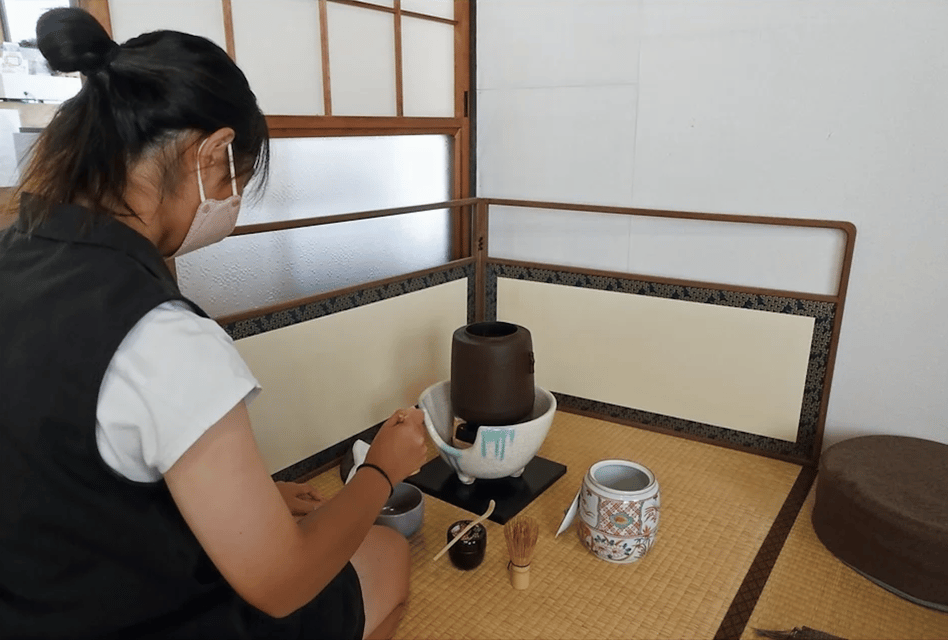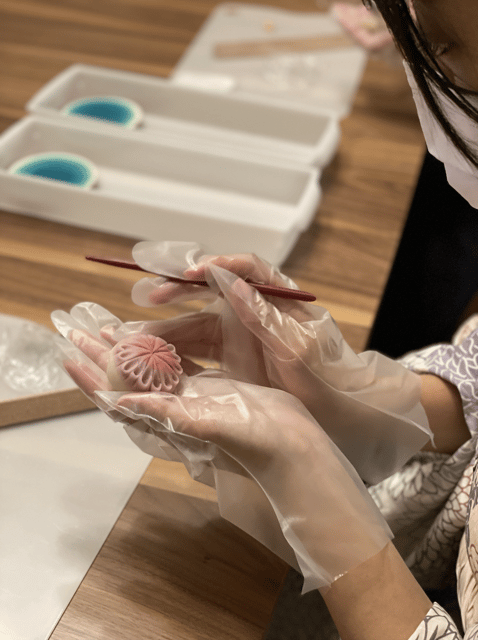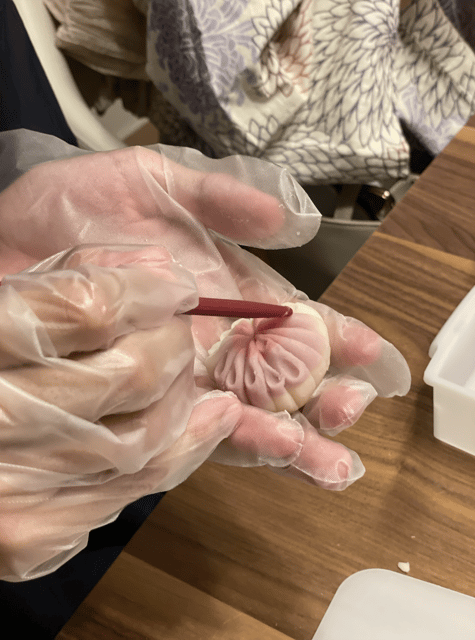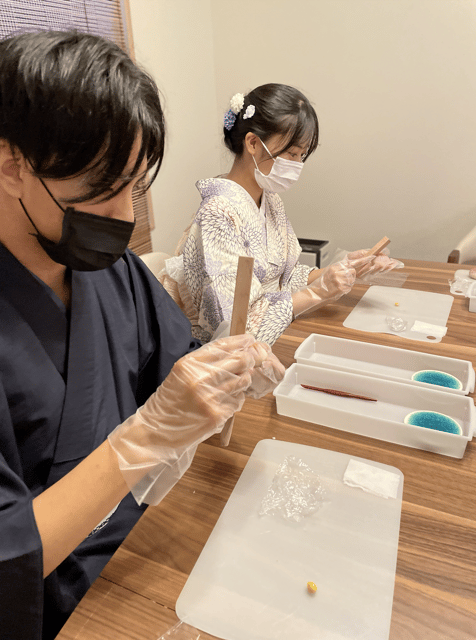The Kiku Plan offers an immersive cultural experience that blends the art of Wagashi making with the timeless tradition of the Japanese tea ceremony. Participants can craft delicate Nerikiri sweets under the guidance of expert instructors, while also savoring the rich flavors of high-quality matcha tea in an authentic setting. This 40-minute session provides a unique opportunity to engage with Japan’s intricate culinary and ceremonial practices, all while discovering the seasonal themes and visual beauty that make Wagashi an enduring cultural treasure. Whether you’re a seasoned enthusiast or simply curious about Japanese traditions, this experience promises to leave a lasting impression on your senses and your understanding of the country’s rich heritage.
Key Points

- The Kiku Plan offers a 40-minute immersive experience in traditional Japanese sweets making and tea ceremony, suitable for up to 8 participants.
- Participants will learn how to craft Nerikiri, a delicate wagashi sweet, under expert guidance and enjoy it with matcha tea in an authentic tea room.
- The experience is priced starting from $24.31 per person, with flexible booking and free cancellation up to 24 hours in advance.
- The tea ceremony portion provides insights into the etiquette and symbolic meanings of the traditional practice, enhancing cultural engagement.
- Participants can optionally purchase a kuromoji, a traditional wooden stick for eating wagashi, to complement the overall experience.
Overview of the Experience

This unique experience allows participants to enjoy the artistry of traditional Japanese sweets making and the tranquility of the tea ceremony.
Over 40 minutes, a small group of up to 8 people will craft a Nerikiri, a delicate wagashi sweet, under the guidance of a skilled instructor.
Afterward, guests will partake in a Japanese tea ceremony in an authentic tea room, savoring the seasonal Nerikiri alongside a carefully prepared matcha tea.
Throughout, participants can engage with the cultural aspects of the experience, creating a memorable journey into the rich traditions of Japan.
You can also read our reviews of more tours and experiences in Yamaguchi.
Pricing and Booking Details

The experience can be booked starting from $24.31 per person.
There’s no upfront payment required – you can reserve now and pay later. The booking process is flexible, allowing for free cancellation up to 24 hours in advance for a full refund.
This makes it easy to plan your visit without worrying about unexpected changes. The pricing is transparent, so you know exactly what you’re paying for.
Whether you’re looking to learn about Japanese culture or simply want to try your hand at traditional sweets making, this experience offers an affordable and convenient way to do so.
Highlights of Wagashi Making

As part of the experience, participants have the opportunity to create a Nerikiri, a traditional Japanese sweet.
Nerikiri are delicate confections made from rice flour, sugar, and water, often molded into seasonal shapes like chrysanthemums or fireworks. Under the guidance of a skilled instructor, guests will learn the intricate techniques of Wagashi making, from kneading the dough to precisely shaping and decorating their creations.
The vibrant natural colors used in Nerikiri, derived from powdered fruits and vegetables, add to the aesthetic appeal of these edible works of art. Crafting a Nerikiri sweet allows participants to enjoy the rich culinary traditions of Japan.
Insights Into the Tea Ceremony

After seeing the art of Wagashi making, participants turn their attention to the captivating world of the Japanese tea ceremony. In the tranquil setting of the tea room, they’ll learn the intricate steps and etiquette of this time-honored tradition. The tea ceremony is a choreographed dance of movements, where every action holds symbolic meaning.
| Ceremony Components | Description |
|---|---|
| Utensils | Carefully selected and arranged teacup, tea scoop, and kettle |
| Matcha | High-quality green tea powder whisked into a frothy brew |
| Hospitality | The host’s gracious and mindful attention to their guests |
Participants will savor the earthy aroma and silky texture of the matcha tea, seeing the peaceful ambiance and exquisite aesthetics of the tea ceremony.
More Great Tours NearbyCultural Engagement and Themes
Throughout this immersive experience, participants revel in the cultural engagement and seasonal themes that permeate the activities.
From creating traditional Nerikiri sweets in the shape of seasonal motifs like chrysanthemums and fireworks, to the serene, centuries-old tea ceremony, the program offers a deep dive into Japanese cultural traditions.
Artisans guide guests through each step, sharing insights into the symbolic meanings and historical significance of these beloved practices.
The relaxed atmosphere encourages participants to fully immerse themselves, fostering a genuine appreciation for the nuances of Japanese aesthetics and the country’s rich heritage.
This well-rounded experience allows visitors to connect with Japan’s cultural treasures on a personal level.
Optional Item and Health Aspect
For an additional touch of Japanese flair, participants can opt to purchase a kuromoji, a traditional wooden stick used for eating wagashi.
These delicate sticks come neatly packaged in a charming kimono-inspired origami container, adding an extra layer of authenticity to the experience.
Beyond the aesthetics, the kuromoji also serves a practical purpose, allowing guests to gracefully consume their handcrafted nerikiri sweets.
Notably, the vibrant colors used in these confections are derived from natural sources, such as powdered fruits and vegetables, ensuring a healthful and visually appealing treat.
This attention to detail showcases the care and artistry inherent in the Japanese culinary tradition.
Restrictions and Meeting Point

This traditional Japanese experience isn’t suitable for all participants.
Wheelchair users and those with a cold are unable to join due to the limitations of the historic tea room venue.
Alcohol, drugs, video recording, and nudity are strictly prohibited during the event to maintain the cultural integrity and privacy of the experience.
Participants will meet at the old folk house, the location of which is available on Google Maps, before being guided to the tea room for the Wagashi making and tea ceremony.
The scenic backdrop and immersive ambiance aim to transport guests into a serene, authentic Japanese setting.
Additional Information
Participants can add a touch of Japanese flair to their experience with an optional Kuromoji, a traditional stick used for eating Wagashi, presented in a charming origami kimono container.
The colors used in the Nerikiri, the traditional Japanese sweets, are derived from powdered fruits and vegetables, offering a healthy and natural twist.
Beyond the delectable treats, the experience provides a glimpse into the rich cultural heritage of Japan, allowing participants to enjoy the serene atmosphere of a tea room and witness the intricate art of tea ceremony.
This well-rounded cultural encounter promises to leave a lasting impression on all who partake.
Frequently Asked Questions

Can I Bring My Own Snacks or Drinks to the Event?
Based on the provided details, it does not appear participants are allowed to bring their own snacks or drinks. The event experience seems to be carefully curated, so outside food and beverages may not be permitted.
Is Photography Allowed During the Experience?
Photography is allowed during the experience, but video recording is prohibited. Participants can capture the intricate process of wagashi making and the serene tea ceremony to preserve their memorable cultural experience.
What Is the Recommended Attire for the Event?
The recommended attire is comfortable, casual clothing that allows for easy movement. Participants should avoid wearing anything too formal or restrictive, as the experience involves delicate wagashi-making and seated tea ceremony activities.
Can I Participate if I Have a Food Allergy?
Individuals with food allergies can participate, but they should inform the organizers in advance. The experience involves making traditional Japanese sweets, so accommodations can be made to ensure participant safety and enjoyment throughout the event.
Is There a Minimum Age Requirement to Join the Experience?
The experience does not have a minimum age requirement, allowing participants of all ages to enjoy the traditional Japanese sweets making and tea ceremony. Families with children are welcome to join this culture activity.
Recap
The Kiku Plan offers an immersive cultural experience, combining the art of Wagashi making and the traditional Japanese tea ceremony. Participants can craft delicate Nerikiri sweets and enjoy high-quality matcha tea in an authentic setting, all while exploring seasonal themes and engaging with Japan’s rich heritage. This 40-minute session is a unique opportunity to explore the captivating world of traditional Japanese craftsmanship and hospitality.
You can check availability for your dates here: